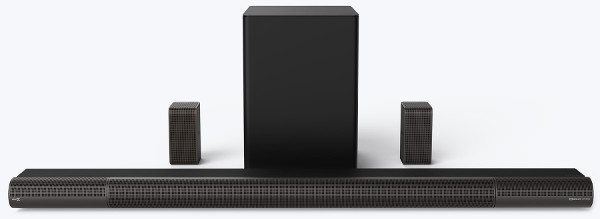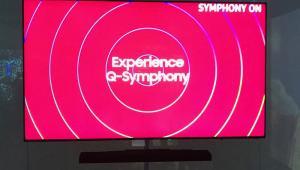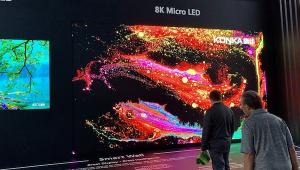Vizio Unveils OLED, Readies Bigger, Brighter LCD TVs

Vizio will also bring the UHD Alliance’s Filmmaker Mode to all 4K TVs, and the company is expanding the use of Samsung-developed HDR 10+ dynamic HDR, which appears in all 4K models in 2020 and joins dynamic Dolby Vision HDR as well as HDR 10 and HLG. HDR10+ was added as a software update in late 2019 to select Vizio 2019 and 2018 TVs.
The plans were announced yesterday as part of a 2020 AV introduction consisting of around 19 new 4K LCD TVs for spring delivery and an unspecified number of 4K OLED TVs. Like before, the P Series Quantum X (PX), P Series Quantum (P9), M8 and M7 series of 4K LCD TVs feature color-gamut-widening quantum-dot technology, which is unavailable in the entry-level 4K V5 series. The M6 series of quantum-dot TVs, launched in late 2019, carries over.
Before the show, Vizio didn’t say how many OLED TVs it would launch later this year, but the company did say its OLEDs would feature HDMI 2.1 features such as 4K/120Hz passthrough, variable refresh rate (VRR) and AMD’s FreeSync for smoother game play, a “borderless” design, a 4mm (0.16-inch) profile, and OLED’s advantages, including deep blacks and wide viewing angle.
Soundbars: In soundbars, Vizio is expanding DTS Virtual:X to all new models to upmix stereo to deliver height and surround effects and upmix multichannel content to add height effects. In soundbars lacking 5.1, 5.1.2, or 5.1.4 driver complements, height and surround effects are delivering via the bar’s 2.0 or 2.1 driver complement.
• Adding a pair of rotating drivers to select Atmos/DTS:X bars, enabling users to rotate them up to bounce height channels off the ceiling or, for stereo and traditional 5.1 playback, rotate the drivers forward to reinforce the front channels.
• Incorporating a dedicated signal-sensing analog input in all new soundbars to connect voice-assistant smart speakers. The input senses when the smart speaker begins to output audio, then diverts the smart speaker’s audio to the soundbar’s amplifier and speakers.
Details of the company’s OLED launch were unavailable, but the company will join LG and Sony in selling OLED TVs in the U.S.
Here’s what else Vizio is talking up in TVs at CES:
Full-Screen Brightness: All quantum-dot LCD TVs get a full-screen brightness boost to enhance HDR performance, with “the most significant improvements” appearing in the M8, P9, and PX series, a spokesman said. Full-screen brightness goes to 800 nits in the PX series, 600 nits in the P9 series, 500 in the M8 series, and 350 in the M7 series. Last year’s full-screen brightness specs were unavailable.
“With the rapid increase of HDR content availability in the marketplace, full-screen brightness becomes a more important factor,” a spokesperson said.
Peak brightness, critical to HDR performance, also got a boost in the M8 series (to 800 nits from 600) and in the M7 series (to 600 from 400). The PX series continues to max out at 3,000 peak nits, and the P9 series continues to max out at 1,200 peak nits.
Size: The company unveiled its first 85-inch LCD TV, appearing in the flagship three-model P Series Quantum X series, and it continues to offer a trio of 75-inch TVs, one each in the PX, P9, and V5 series. The latter series also continues to offer a 70-inch screen.
Contrast: In the three-model flagship PX series, the number of contrast-enhancing back-lit local dimming zones goes up to 792 in the 85-inch screen size, up from a maximum 480 in the 2019 series’ 75-inch model and 384 in the 65-inch model. In 2020, the PX series retains the 75- and 65-inch sizes, but information was unavailable on their zone counts.
Like last year, the M8 series continues to max out at 90 zones, but the M7 series gets a slight upgrade to a maximum 30 zones from 20. The V5 series offers full-array LED lighting without local dimming.
Color gamut: Vizio continues to max out at 85% of the Rec. 2020 standard in 4K LCD TVs, with the number of models meeting that level growing from two SKUs in 2019 to three with the expansion of the PX series. P9 series coverage is close to 83% of Rec. 2020, with M series at around 80%, a spokesman said.
For reference, 100% of the widely quoted P3 standard equals about 73% of the Rec. 2020 standard.
HDMI 2.1: All 4K models get select HDMI 2.1 features, including eARC, ALLM, VRR and, in the PX and P9 series and OLED series, the ability to display 4K content at up to 120fps.
Filmmaker Mode: The feature, which will appear across al 4K TVs, was developed by the UHD Alliance (UHDA) and Hollywood to preserve the look and feel of movies and TV shows as intended by the filmmaker. The mode displays content in the aspect ratio and frame rate in which it was mastered and turns off noise reduction, picture sharpening, and other post-processing effects, including motion smoothing.
Voice remotes: Another feature making its debut is a microphone-equipped remote that delivers voice control, via Bluetooth, of all basic Vizio TV functions as well as advanced TV functions, including content search and app launching. Because a remote button must be pressed to activate voice control, privacy is enhanced because the mic isn’t always listening for a wake word, the company said. Because the remote features two-way Bluetooth, it can receive updates via Vizio’s Internet-connected smart TVs.
As in 2019 models, TV functions can also be controlled via Google Assistant and Amazon Alexa smart speakers as well as by Siri.
Gaming Features: All quantum-dot models will feature a host of gaming-performance features dubbed ProGaming Engine. The features include variable refresh rate (VRR) to sync the TV’s refresh rate to the video game’s frame rate for smoother game play, AMD FreeSync VRR technology for use with computers and games incorporating FreeSync, and less-than 15ms input lag for quick response to commands. Vizio also developed an HDR tone-mapping curve exclusively for games to deliver a “more expansive dynamic range,” a spokesperson said.
The non-quantum-Dot V series features VRR and ALLM.
SmartCast Updates: In unveiling SmartCast 4.0, the latest iteration of its smart TV platform with Chromecast Built-in, Vizio said it will offer faster response time, redesigned search from all streaming apps, a deeper content-browsing experience launched from the home page for more specific searches within a genre, and more personalization by surfacing content recommendations based on viewing habits and apps used.
The roughly 150 channels of content available through Vizio’s WatchFree streaming service will be accessible from a dedicated remote button, and consumers will now be able to tag favorite channels, navigate by genre, and use Google Assistant and Amazon Alexa smart speakers to select channels or titles.
ATSC 3.0: The company also said it is still “evaluating the right time” to include ATSC 3.0 (Next Gen TV) over-the-air TV tuners in its TVs, contending that it is meeting with TV broadcasters to learn about their ATSC 3.0 plans and pointing out the costs of implementation. Vizio has “to look at overall value” in adding features, said John Hwang, VP of hardware product management.
ATSC 3.0 broadcasts will support 1080p and 4K video resolutions (up from the current 720p and 1080i), 10-bit versus 8-bit video, HDR, wide color gamut (WCG), frame rates up to 120Hz from 60Hz, object-based 3D surround sound with up to 7.2.4 channels, and — because the standard is based on the Internet Protocol — interactive and personalized content, including interactive advertising.


- Log in or register to post comments





























































